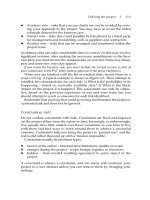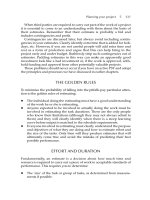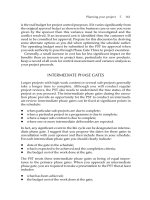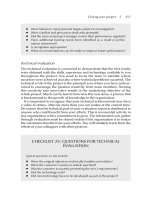Management a practical introduction 3rd kinicky chapter 11
Bạn đang xem bản rút gọn của tài liệu. Xem và tải ngay bản đầy đủ của tài liệu tại đây (188.26 KB, 39 trang )
Management
A Practical Introduction
Third Edition
Angelo Kinicki &
Brian K. Williams
Kinicki/Williams, Management: A Practical Introduction 3e ©2008, McGraw-Hill/Irwin
Chapter 11: Managing Individual
Differences & Behavior
Supervising People as People
Values, attitudes, & behavior
Dealing with work-related attitudes &
behavior
Personality & individual behavior
Perception & individual behavior
Workplace stress
Kinicki/Williams, Management: A Practical Introduction 3e ©2008, McGraw-Hill/Irwin
2
11.1 Values, Attitudes, & Behavior
HOW DO INDIVIDUAL VALUES AND
ATTITUDES AFFECT PEOPLE’S ACTIONS?
Organizational behavior (OB) is dedicated to
better understanding and managing people at work
OB focuses on individual behavior and group
behavior and tries to help managers explain
behavior and predict behavior
Abstract ideals that guide one’s thinking and
behavior across all situations are values
For managers, values are the things for which
people are willing to work hard
Kinicki/Williams, Management: A Practical Introduction 3e ©2008, McGraw-Hill/Irwin
3
Manager’s Toolbox
Leading Younger Workers in Attaining Job Satisfaction
By 2010 U.S. will have 8M more jobs than workers to do them
Companies will have to learn how to keep younger workers
Less trusting of authority in general and want success now
Suggestions on how to manage younger workers:
Make training an obsession
Allow them independent learning while creating bonds with
mentors
Teach people by showing them their results
Provide frequent feedback
Provide frequent rewards for great performance
McGraw-Hill/Irwin
Kinicki/Williams, Management: A Practical Introduction 3e ©2008, McGraw-Hill/Irwin
4 © 2006 The McGraw-Hill Companies, Inc. All rights reserved.
Organizational Behavior
Organizational Behavior (OB): which is
dedicated to better understanding and
management of people at work.
Tries to help managers not only explain
workplace behavior, but also how to
predict it
Looks at:
Individual Behavior: values, attitudes, personality, perception,
and learning
Group Behavior: norms, roles, and teams
McGraw-Hill/Irwin
Kinicki/Williams, Management: A Practical Introduction 3e ©2008, McGraw-Hill/Irwin
5 © 2006 The McGraw-Hill Companies, Inc. All rights reserved.
Values & Attitudes
Values: are abstract ideas that guide one’s
thinking and behavior across all situations.
Fairly well set in early teens and dictate lifelong
behavior patterns
Willing to work hard for
Can be reshaped by significant life-altering events
Compensation, recognition, and status – common
values in the workplace
Younger workers may value balance between work
and life
McGraw-Hill/Irwin
Kinicki/Williams, Management: A Practical Introduction 3e ©2008, McGraw-Hill/Irwin
6 © 2006 The McGraw-Hill Companies, Inc. All rights reserved.
Values & Attitudes
Attitudes: learned predispositions
toward given objects.
Values are abstract ideals that are directed toward
all objects, people, or events
Attitudes are beliefs and feelings that are directed
toward specific objects, people, or events
Employees’ attitudes toward their jobs are stable
over time
McGraw-Hill/Irwin
Kinicki/Williams, Management: A Practical Introduction 3e ©2008, McGraw-Hill/Irwin
7 © 2006 The McGraw-Hill Companies, Inc. All rights reserved.
11.1 Values, Attitudes, & Behavior
Attitudes have three components:
-the affective component consists of the
feelings or emotions one has about a situation
-the cognitive component consists of the
beliefs and knowledge one has about a situation
-the behavioral component (also known as the
intentional component) refers to how one
intends or expects to behave toward a situation
Together, values and attitudes influence
workplace behavior (actions and judgments)
Kinicki/Williams, Management: A Practical Introduction 3e ©2008, McGraw-Hill/Irwin
8
The Three Components of Attitudes
1. Affective: consists of feelings or emotions one
has about a situation – “I feel.”
“I really like working from home.”
2. Cognitive: consists of the beliefs and
knowledge one has about a situation – “I
believe.”
“The tallest building in the world is in Chicago.” (wrong)
3. Behavioral (a.k.a. the intentional component):
refers to how one intends or expects to
behave toward a situation – “ I intend.”
McGraw-Hill/Irwin
“I intend to fill out my expense report tomorrow.”
Kinicki/Williams, Management: A Practical Introduction 3e ©2008, McGraw-Hill/Irwin
9 © 2006 The McGraw-Hill Companies, Inc. All rights reserved.
Examples of the Three Components
Affective
I hate people who talk on cell phones in restaurants
I hate putting on a suit for work
I really like working from home
I like commuting be train because I have time for myself
I don’t like working in office cubicles because they don’t have
doors so there’s no privacy
Cognitive
I can’t appoint Herschel because creative people don’t make
good administrators
The tallest building in the world is in Chicago
Behavioral
I intend to fill out my expense report tomorrow
I’m going to turn over a new leaf at New Year’s and stop eating
junk food
I’m going to try to avoid John because he’s a Democrat
I’m never going to talk to George because he’s a Republican
McGraw-Hill/Irwin
Kinicki/Williams, Management: A Practical Introduction 3e ©2008, McGraw-Hill/Irwin
10 © 2006 The McGraw-Hill Companies, Inc. All rights reserved.
11.1 Values, Attitudes, & Behavior
The term cognitive dissonance was proposed by
Leon Festinger to describe the psychological
discomfort a person experiences between his or her
cognitive attitude and incompatible behavior
How people deal with the discomfort depends on
the importance of the elements creating dissonance,
how much control they have over the matters that
create dissonance, and what rewards are at stake
To reduce cognitive dissonance, people, change
their attitude and/or behavior, belittle the
importance of the inconsistent behavior, find
consonant elements that outweigh the dissonant
ones
Kinicki/Williams, Management: A Practical Introduction 3e ©2008, McGraw-Hill/Irwin
12
11.2 Work Related Attitudes & Behaviors
Managers Need To Deal With
DO MANAGERS NEED TO PAY ATTENTION TO
EMPLOYEE ATTITUDES?
Managers need to be aware that attitudes affect
behavior—a happy employee will perform better
Managers need to be particularly interested in job
satisfaction, job involvement, organizational
commitment, and organizational citizenship
1. The extent to which a person feels positively or
negatively about various aspects of their work is
their job satisfaction
Job satisfaction usually depends on things like
work, pay, promotions, co-workers, and supervision
Kinicki/Williams, Management: A Practical Introduction 3e ©2008, McGraw-Hill/Irwin
13
11.2 Work Related Attitudes & Behaviors
Managers Need To Deal With
2. The extent to which people identify with or are
personally involved with their job is job
involvement
Satisfying work environments are likely to
promote job involvement
3. Organizational commitment reflects the extent
to which an employee identifies with an
organization and is committed to its goals
There is a strong relationship between
organizational commitment and job satisfaction
4. Employee behaviors that are not directly
part of employees’ job descriptions - that exceed
their work-role requirements are called
organizational citizenship behaviors
There is a positive relationship between
organizational citizenship and job satisfaction
Kinicki/Williams, Management: A Practical Introduction 3e ©2008, McGraw-Hill/Irwin
14
11.2 Work Related Attitudes & Behaviors
Managers Need To Deal With
Managers need to manage two
behaviors: performance and productivity,
and absenteeism and turnover
The method a manager uses to evaluate
performance must match the job being
done
Absenteeism (when an employee doesn’t
show up for work) is related to job
dissatisfaction
Absenteeism may be a precursor to
turnover (when employees leave their
jobs)
Kinicki/Williams, Management: A Practical Introduction 3e ©2008, McGraw-Hill/Irwin
16
11.3 Personality & Individual Behavior
WHY ARE PERSONALITIES IMPORTANT?
Personalities (stable psychological traits
and behavioral attributes that give people
their identity) are important for managers
to understand because they affect how
people perceive and act
The Big Five personality dimensions are
extroversion, agreeableness,
conscientiousness, emotional stability, and
openness to experience
Kinicki/Williams, Management: A Practical Introduction 3e ©2008, McGraw-Hill/Irwin
17
11.3 Personality & Individual Behavior
where:
-extroversion refers to how outgoing, talkative,
sociable, and assertive a person is
-agreeableness refers to how trusting, goodnatured, cooperative, and soft-hearted, and
persistent one is
-conscientiousness refers to how dependable,
responsible, achievement-oriented, and
persistent one is
-emotional stability refers to how relaxed,
secure, and unworried one is
-openness to experience refers to how
intellectual, imaginative, curious, and broadminded one is
Kinicki/Williams, Management: A Practical Introduction 3e ©2008, McGraw-Hill/Irwin
18
Cautions About Using Personality
Tests in the Workplace
Use professionals
Don’t hire on the basis of personality tests
alone
Be alert for gender, racial and ethnic bias
McGraw-Hill/Irwin
Kinicki/Williams, Management: A Practical Introduction 3e ©2008, McGraw-Hill/Irwin
19 © 2006 The McGraw-Hill Companies, Inc. All rights reserved.
11.3 Personality & Individual Behavior
DO PERSONALITY TESTS PREDICT
BEHAVIOR IN THE WORKPLACE?
Extroversion (an outgoing personality) has been
associated with management success
Conscientiousness (a dependable personality) is
strongly correlated with job performance and
training performance
An individual who scores well on
conscientiousness is probably a good worker and
may have a proactive personality (be more apt to
take initiative and persevere to influence the
environment)
Kinicki/Williams, Management: A Practical Introduction 3e ©2008, McGraw-Hill/Irwin
22
Five Important Traits in Organizations
1. Locus of Control “I am/am not the master
of my fate.” : indicates how much people
believe they control their fate through
their own efforts.
Internal Locus of Control – you believe you control
your own fate
Probably resist close management supervision
External Locus of Control – you believe external
forces control you
Do better in highly structured jobs requiring
greater compliance
McGraw-Hill/Irwin
Kinicki/Williams, Management: A Practical Introduction 3e ©2008, McGraw-Hill/Irwin
23 © 2006 The McGraw-Hill Companies, Inc. All rights reserved.
Five Important Traits in Organizations
2. Self-efficacy – “I can/cannot do this
task.” : belief in one’s personal ability to
do a task.
Involves your personal belief that you have what it
takes to succeed.
High expectations are linked with all kinds of
positives
Low self-efficacy associated with learned
helplessness – the debilitating lack of faith in one’s
ability to control one’s environment.
McGraw-Hill/Irwin
Kinicki/Williams, Management: A Practical Introduction 3e ©2008, McGraw-Hill/Irwin
24 © 2006 The McGraw-Hill Companies, Inc. All rights reserved.
Five Important Traits in Organizations
2. Self-efficacy (cont.)
Job assignments
Complex, challenging, and autonomous jobs
enhance people’s perceptions of their self-efficacy
Boring, tedious jobs generally do the opposite
Developing self-efficacy
Employees with low self-efficacy need lots of
constructive pointers and positive feedback
Expectations can be improved through guided
experiences, mentoring, and role modeling
McGraw-Hill/Irwin
Kinicki/Williams, Management: A Practical Introduction 3e ©2008, McGraw-Hill/Irwin
25 © 2006 The McGraw-Hill Companies, Inc. All rights reserved.
Five Important Traits in Organizations
3. Self-esteem – “I like/dislike myself.” : extent
to which people like or dislike themselves.
People with high self-esteem
More apt to handle failure better and to take on
more tasks
When faced with pressure situations become more
egotistical and boastful
People with low self-esteem
When confronted with failure, have primarily
negative thoughts
More dependent on others and less likely to take
independent positions
McGraw-Hill/Irwin
Kinicki/Williams, Management: A Practical Introduction 3e ©2008, McGraw-Hill/Irwin
26 © 2006 The McGraw-Hill Companies, Inc. All rights reserved.
Ways Managers Can Boost Employee SelfEsteem
Reinforce employee’s positive attributes and
skills
Provide positive feedback whenever possible
Break larger projects into smaller tasks and
projects
Express confidence in employees’ abilities to
complete their tasks
Provide coaching whenever employees are seen
to be struggling to complete tasks
McGraw-Hill/Irwin
Kinicki/Williams, Management: A Practical Introduction 3e ©2008, McGraw-Hill/Irwin
27 © 2006 The McGraw-Hill Companies, Inc. All rights reserved.
Five Important Traits in Organizations
4. Self-monitoring – “I’m fairly able/unable to
adapt my behavior to others.” : the extent to
which people are able to observe their own
behavior and adapt it to external situations.
Some high self-monitors are criticized for being
chameleons
Low self-monitors are often insensitive to others
People in top management are more apt to be selfmonitors able to play different roles
Positive relationship between high self-monitoring and
career success
McGraw-Hill/Irwin
Kinicki/Williams, Management: A Practical Introduction 3e ©2008, McGraw-Hill/Irwin
28 © 2006 The McGraw-Hill Companies, Inc. All rights reserved.
Five Important Traits in Organizations
5. Emotional intelligence is the ability to
cope, empathize with others, and be selfmotivated
The traits of emotional intelligence are
self awareness, self-management, social
awareness, and relationship management
Kinicki/Williams, Management: A Practical Introduction 3e ©2008, McGraw-Hill/Irwin
34









